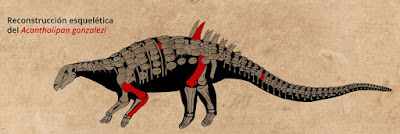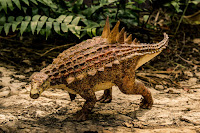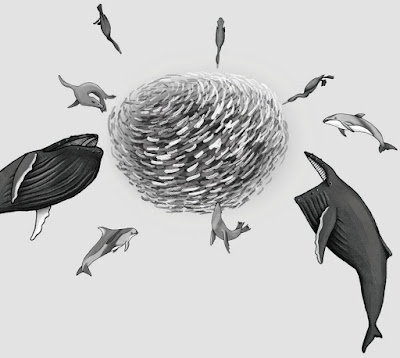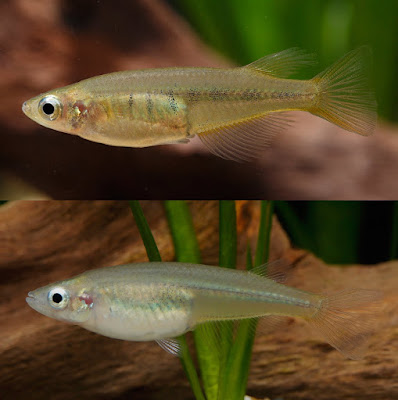[Most Recent Entries] [Calendar View]
Thursday, June 14th, 2018
| Time | Event | ||
| 2:02a | [Paleontology • 2018] Acantholipan gonzalezi • Paleodiversity of Late Cretaceous Ankylosauria from Mexico and Their Phylogenetic Significance
Abstract Isolated bones and osteoderms of ankylosaurian dinosaurs recovered from Late Cretaceous sediments of northern Coahuila, northeastern Mexico, have been identified as remains of nodosaurids. Here, we summarize these discoveries and provide a review on Mexican Ankylosauria from a taxonomic perspective. We also present a new taxon, Acantholipan gonzalezi gen. et sp. nov. from the Pen Formation and provide a phylogenetic analysis integrating the new taxon. A. gonzalezi is the first named ankylosaur from Mexico that adds to the currently rare nodosaurid diversity from southern Laramidia. Keywords: Dinosaur, Nodosauridae, Pen Formation, Mexico, Endemism, Laramidia Dinosauria Owen (1842) Ornithischia Seeley (1887) Thyreophora Nopcsa (1915) Ankylosauria Osborn (1923) Nodosauridae Marsh, 1890 Acantholipan gen. nov. Acantholipan gonzalezi sp. nov. Etymology: Greek αγκάθι (acanthus) = spine; and the Spanish contraction of Lépai-Ndé (gray people) lipan, a tribe of Apaches from northern Mexico; gonzalezi = in honor of Arturo H. Gonzalez González, for his outstanding support to Mexican paleontology. Héctor E. Rivera-Sylva, Eberhard Frey, Wolfgang Stinnesbeck, Gerardo Carbot-Chanona, Iván E. Sanchez-Uribe and José Rubén Guzmán-Gutiérrez. 2018. Paleodiversity of Late Cretaceous Ankylosauria from Mexico and Their Phylogenetic Significance. Swiss Journal of Palaeontology DOI: 10.1007/s13358-018-0153-1 Rivera-Sylva, H.E., Carpenter, K. and Aranda-Manteca, F.J. 2011, Late Cretaceous Nodosaurids (Ankylosauria: Ornithischia) from Mexico. Revista Mexicana de Ciencias Geológicas. 28(3); 271–278. satori.geociencias.unam.mx/28-3/(04)Rive Presenta el MUDE nueva especie de dinosaurio: Acantholipan Gonzalezi elheraldodesaltillo.mx/2018/06/11/presen Descubren nueva especie de dinosaurio acorazado en Coahuila http://diario19.com/archivos/35634/descu | ||
| 9:55a | [Botany • 2018] Pleurothallis hawkingii & P. vide-vallis (Orchidaceae; Epidendroideae) • Two New Species from Cordillera de Guanacaste in Costa Rica
Abstract Two new species of Pleurothallis are described from the Cordillera de Guanacaste in northern Costa Rica. Both novelties belong to Pleurothallis sect. Macrophyllae-Fasciculatae, among which they can be recognised by their fasciculate inflorescence with numerous simultaneously produced flowers, a rare feature in the species-rich group. This feature is shared with Pleurothallis bothros, putatively their closest relative. Both novelties may be distinguished from that species by their non-spreading (vs. spreading), pale yellow to pinkish flowers (vs. green) and broad, oblique petals (vs. narrow, straight). Pleurothallis hawkingii can be easily distinguished from Pleurothallis vide-vallis by its broader panduriform lip with raised margins and depressed basal glenion (vs. narrow lanceolate lip, lacking raised margins, with the glenion raised on a high basal callus). Keywords: Monocots, Northern Costa Rica; Miravalles; new species; Pleurothallis; Stephen Hawking; taxonomy Pleurothallis hawkingii Karremans & J.E.Jiménez sp. nov. Eponomy:— Honouring the English theoretical physicist, cosmologist and author Stephen William Hawking, who passed away the day this manuscript was submitted, 14 March 2018. .... Pleurothallis vide-vallis Karremans & J.E.Jiménez, sp. nov. Etymology:—From the Latin, videre, to see, and vallis, valley, referring to the Miravalles Volcano, which in Spanish means overlooking the valleys. Adam P. Karremans and José Esteban Jiménez. 2018. Pleurothallis hawkingii and Pleurothallis vide-vallis (Orchidaceae; Epidendroideae), Two New Species from Cordillera de Guanacaste in Costa Rica. Phytotaxa. 349(2); 185–191. DOI: 10.11646/phytotaxa.349.2.10 | ||
| 10:05a | [Ecology • 2018] The Evolution of Foraging Capacity and Gigantism in Cetaceans
ABSTRACT The extant diversity and rich fossil record of cetaceans provides an extraordinary evolutionary context for investigating the relationship between form, function and ecology. The transition from terrestrial to marine ecosystems is associated with a complex suite of morphological and physiological adaptations that were required for a fully aquatic mammalian life history. Two specific functional innovations that characterize the two great clades of cetaceans, echolocation in toothed whales (Odontoceti) and filter feeding in baleen whales (Mysticeti), provide a powerful comparative framework for integrative studies. Both clades exhibit gigantism in multiple species, but we posit that large body size may have evolved for different reasons and in response to different ecosystem conditions. Although these foraging adaptations have been studied using a combination of experimental and tagging studies, the precise functional drivers and consequences of morphological change within and among these lineages remain less understood. Future studies that focus at the interface of physiology, ecology and paleontology will help elucidate how cetaceans became the largest predators in aquatic ecosystems worldwide. Keywords: Scaling, Odontocetes, Mysticetes, Diving, Filter feeding, Echolocation J. A. Goldbogen and P. T. Madsen. 2018. The Evolution of Foraging Capacity and Gigantism in Cetaceans. Journal of Experimental Biology. 221: jeb166033. DOI: 10.1242/jeb.166033 | ||
| 10:27a | [Ichthyology • 2018] Oryzias dopingdopingensis • A New Riverine Ricefish of the Genus Oryzias (Beloniformes, Adrianichthyidae) from Malili, Central Sulawesi, Indonesia We describe Oryzias dopingdopingensis, a new species of ricefish, from Doping-doping River, a river in Malili in central Sulawesi, Indonesia. The new riverine species is distinguished from lacustrine congeners in Malili Lakes by a combination of 33–36 scales along the lateral midline and body depths of 20.3–25.5% standard length (SL). Oryzias dopingdopingensis, new species, is also distinguished from all other Sulawesi Oryzias by a combination of 8–9 dorsal-fin rays, caudal peduncle depths of 10.2–11.4% SL, eye diameters of 8.5–9.9% SL, and maximum SL up to 35.8 mm. In breeding males, 5–8 black blotches or bars appear along the lateral midline. Analyses of mitochondrial ND2 sequences revealed that O. dopingdopingensis, new species, carry distinct haplotypes from those of the Malili lacustrine species, suggesting no hybridization between them, although Doping-doping River shares an estuarine region with the Malili Lake system. Instead, O. dopingdopingensis, new species, is in a monophyletic group with O. sarasinorum and O. eversi in western Sulawesi. However, unlike these two pelvic brooders, we observed that females of O. dopingdopingensis, new species, deposit eggs soon after spawning and exhibit no maternal care.
Oryzias dopingdopingensis, new species Doping-doping Ricefish New Japanese name: Dopindopin-medaka ... Etymology.— The specific name, dopingdopingensis, denotes the occurrence of this species in the Doping-doping River, the type locality.  Ixchel F. Mandagi, Daniel F. Mokodongan, Rieko Tanaka and Kazunori Yamahira. 2018.A New Riverine Ricefish of the Genus Oryzias (Beloniformes, Adrianichthyidae) from Malili, Central Sulawesi, Indonesia. Copeia. 106(2):297-304. DOI: 10.1643/CI-17-704 Kami mendiskripsikan Oryzias dopingdopingensis, satu jenis baru ikan padi dari sungai Doping-doping, sebuah sungai di Malili di Sulawesi Tengah, Indonesia. Jenis baru yang hidup di sungai ini dibedakan dari jenis yang hidup di danau-danau Malili dengan kombinasi dari 33–36 jumlah sisik sepanjang garis sisi dan lebar tubuh 20.3–25.5% SL. Oryzias dopingdopingensis, jenis baru ini, juga dibedakan dari semua Oryzias Sulawesi lainnya dengan kombinasi dari 8–9 jumlah jari-jari sirip belakang, lebar dari batang ekor 10.2–11.4% SL, diameter mata 8.5–9.9% SL, dan maksimal SL mencapai 35.8 mm. Jantan dalam masa perkembangbiakannya, 5–8 bercak-bercak hitam atau baris akan muncul di sepanjang garis sisi. Analisis urutan mitokondria ND2 memperlihatkan bahwa O. dopingdopingensis, jenis baru ini, memiliki haplotype yang berbeda dari jenis yang hidup di daerah danau Malili, Ini menunjukkan tidak terjadi hibridisasi diantara mereka, walaupun Sungai Doping-doping berbagi wilayah muara dengan Danau Malili system. Sebagai gantinya, O. dopingdopingensis, jenis baru ini, menjadi monofiletik dengan O. sarasinorum dan O. eversi di Sulawesi bagian barat. Tidak seperti dua “pelvic brooders”, bagaimanapun, kami mengamati bahwa betina dari O. dopingdopingensis, jenis baru ini, melepaskan telur-telurnya segera setelah pemijahan dan tidak menunjukkan “maternal care”. |
| << Previous Day |
2018/06/14 [Calendar] |
Next Day >> |










